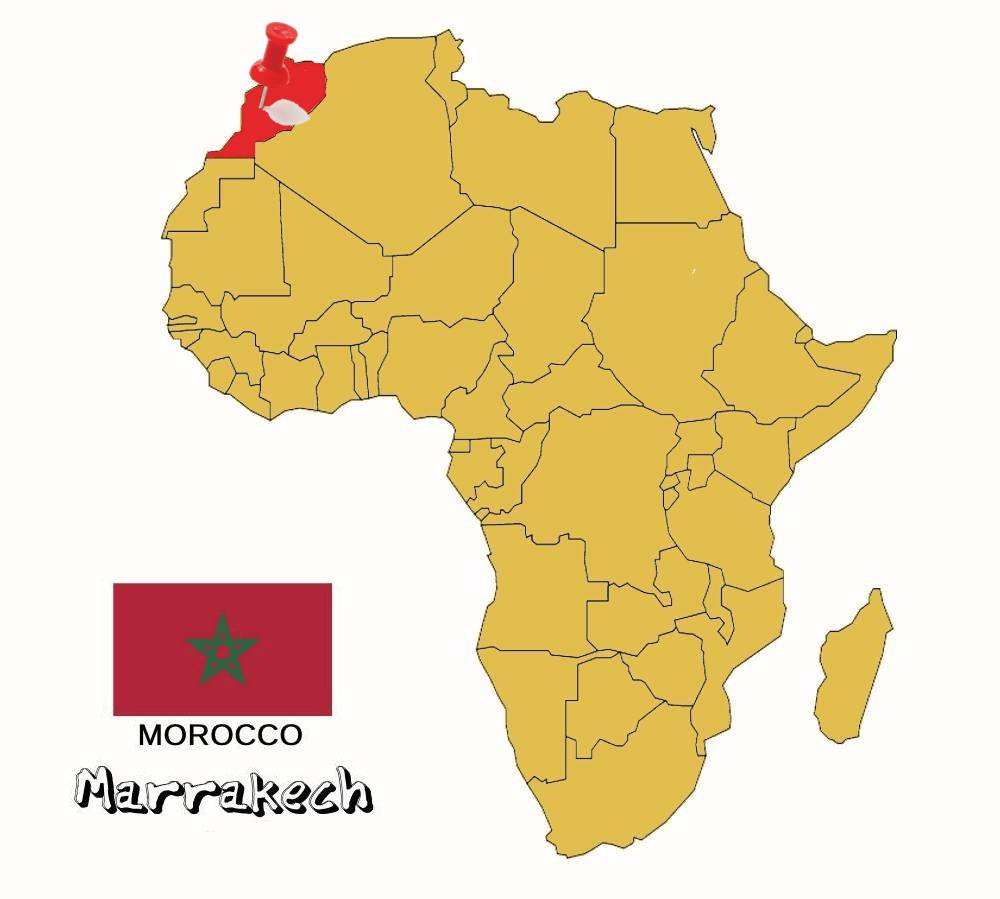
Marrakech gathers elements from the Mediterranean and North Africa, thus creating a unique destination that will definitely be unforgettable. The "daughter of the desert" is full of traditional covered markets, picturesque alleys, impressive mosques, colonial buildings, interesting museums and more waiting to be discovered.
A few words about the city
Marrakech is a city in southwestern Morocco near the Atlas Mountains. The Medina of the city has been a Unesco World Heritage Site since 1985, which has given it the nickname "Red City" because of the color of all its buildings. The name of the town comes from the Berber words Mur (n) akuch, meaning God's country, while the very name of Morocco comes from the same root! Marrakech has the largest traditional bazaar in the country and the busiest square in all of Africa, Jemaa el Fna, as well as various other attractions that are difficult to find in other Arab cities! According to the latest census, the population of the city is 1,049,690 inhabitants, being the fourth largest city in Morocco. So I will try to introduce you to Marrakesh through my own eyes and share with you what I believe that someone who visits it for the first time should see.
Koutoubia Mosque
The Koutoubia Mosque is one of Marrakesh's most famous sights and the largest mosque in the city. It dates from 1162 and is considered one of the greatest achievements of Almohad architecture. Local legend says that when it was first built, the muezzin (the man who calls the faithful to pray) for this mosque had to be blind, as the minaret was so high that he could see the harem of the ruler! In fact, the impressive minaret of Koutoubia is 70 meters high and is visible for miles in every direction! The site of the archaeological excavation on the northwestern side of the minaret shows the foundations of the most ancient mosque built on this site. It was destroyed by the Almohads and replaced with the present mosque. Unfortunately, only Muslims are allowed to enter!
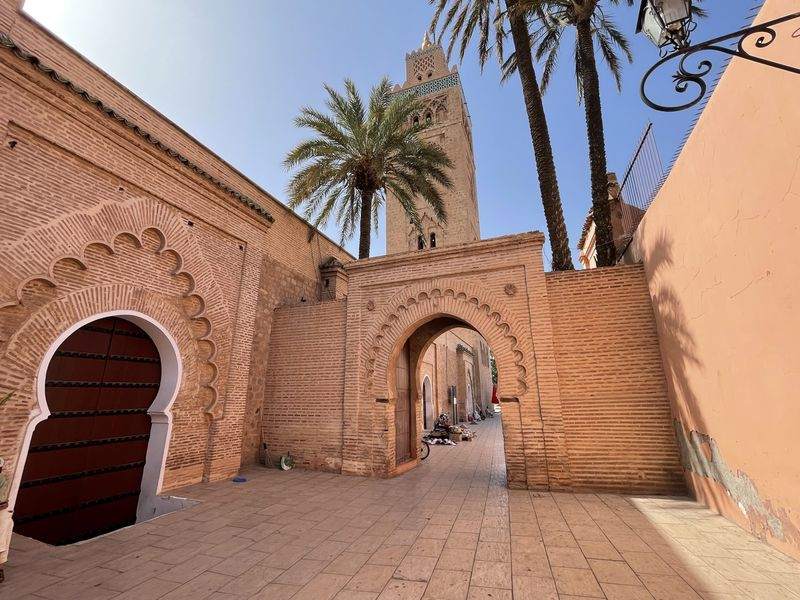
Jemaa El Fna
Jemaa el-Fnaa square is located at the entrance of the old city and is considered the center of life in Marrakech. In this place you will find what you might have in mind when you hear the word Morocco. During the morning hours it is a traditional North African market, catering to both the daily needs of the locals and the tourist trade. There you will discover everything from fakirs sitting on nails, fortune tellers, musicians women doing henna tattoos to snake people and monkeys! As the sunlight falls, they all leave and give way to dozens of canteens with traditional dishes! If you want to escape the hustle and bustle, I suggest going up to one of the rooftops of the numerous cafes or restaurants around to see the square from above!
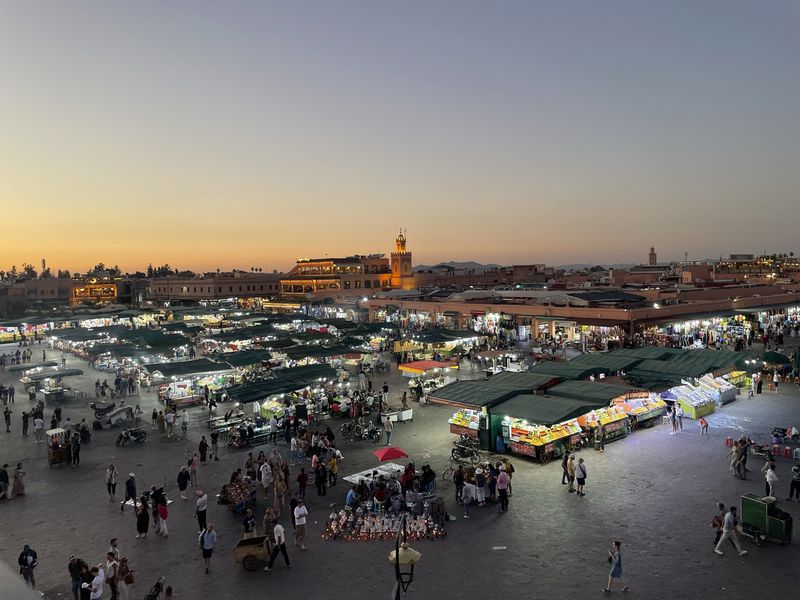
Bahia Palace
Bahia Palace is undoubtedly the city's most important and popular attraction. It is a typical example of Moroccan architecture, which began construction in 1880 and was completed in 1900. The palace was erected under the orders of Grand Vizier Ba Ahmed, who served Sultan Moulay Al-Hassan I. During the construction of the palace, the plans were constantly changing, as a result of which most of the chambers were completed separately, turning it into a huge labyrinth. The interior decoration is characterized by a dazzling array of zeliz tiles, painted ceilings and ornate forgings, demonstrating the rich lives of those high in the Sultan's favor at the time. Like most of the buildings erected in Arab-Andalusian style, the Bahia Palace has a delightful garden and a charming courtyard, filled with cypresses, banana trees, orange trees and fountains, making it an oasis of peace within the bustling city. After Ba Ahmed's death, the Palace became royal property. A few hours after his death, Sultan Abdelaziz (who then assumed full power in the country) allegedly ordered the palace to be ransacked for valuable items. So unluckily today all the halls are empty, yet it still remains dazzling and definitely worth visiting while in the city. Admission costs 70 dirhams, which is about 6.5e.
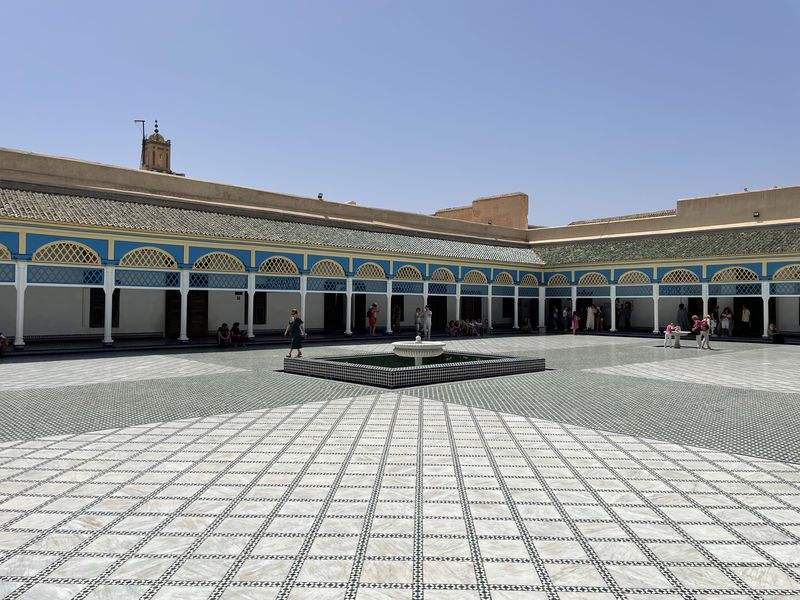
El Badi Palace
The other palace of the city is not as luxurious, but it is equally impressive. I refer, of course, to El Badi Palace, which was once Al-Mansur's largest and main palace, which earned it the nickname, "The Palace of Miracles." It was ordered by the Sultan a few months after his rise to power in 1578, with construction and adornment continuing throughout his reign. The palace was decorated with materials imported from various countries, such as gold, ivory, marble, etc., while it was used for banquets and designed to showcase the wealth and power of the Sultan! El Badi was neglected after Al-Mansur's death in 1603 and finally destroyed after the decline of the Saadi dynasty. Its precious materials (particularly marble) were removed and reused in other buildings throughout Morocco, with the result that today we see mostly ruins. However, even so, the enormous size of the palace with its over three hundred rooms will surely enchant you. Walk through the gardens with the towering trees and fountains, admire the remains of the mosaic tiles, enter the dungeons where the prisoners were held by the Sultan and climb to the top of the walls to admire the panoramic view of the whole city. Admission costs 70 dirhams, which is about 6.5e.
Majorelle Gardens
Majorelle Gardens are the work of the famous painter Jacques Majorelle. Majorelle, for health reasons, moved from Nancy, France, to Marrakech and became known for his paintings of local Moroccan life. After his death in 1962, renowned French designer Yves Saint Laurent bought the property, and it became known to the general public. In fact, after the death of Yves Saint Laurent, his ashes were scattered in the gardens! Today, this place is an attraction for anyone who visits the city. It is a veritable oasis, filled with palm trees, cactus, bougainvillea, ferns, lakes and fountains, with the old Majorelle painting studio as a hallmark. This blue building has now been transformed into a small Museum of Islamic Art, which is dedicated to Berber and North African art. If you are planning to be there, you should book your ticket online in advance. Because of its popularity, queues are always huge and tickets are now sold only online! The ticket to the gardens costs 150 dirhams, which is about 14e. Finally, right next door is a museum dedicated to the life of Yves Saint Laurent (Musée Yves Saint Laurent) and the legacy he left in fashion, the ticket for which costs 130 dirhams (about 12e).
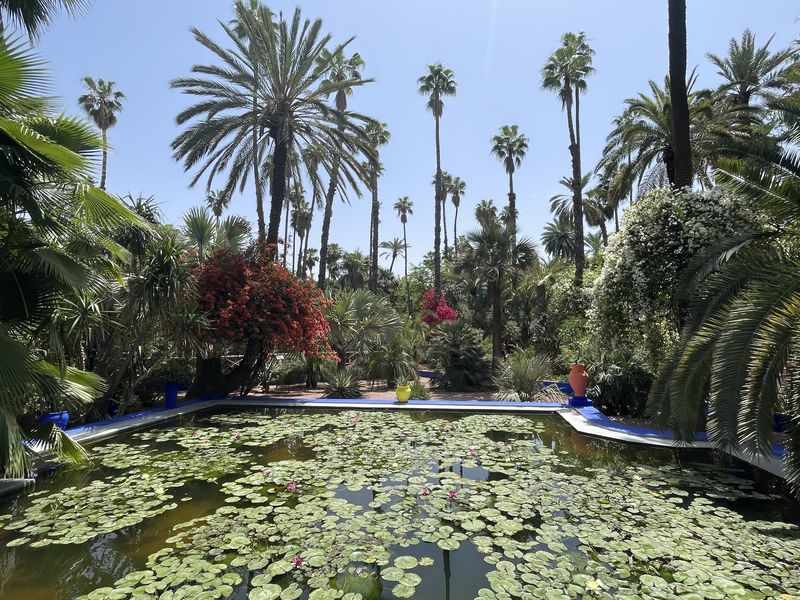
Medersa Ben Youssef
This particular building will be one of the most beautiful schools you will ever see with your own eyes. Medersa Ben Youssef was the largest theological college in Morocco. This particular theological school is named after the adjacent Ben Yusef Mosque, constructed by the Almoravid Sultan Ali ibn Yusuf. It is located in the heart of the old city and was constructed in 1565 by the Saadi, and once housed over 900 students! It consists of 130 student cells, clustered around small inner courtyards and is considered a typical example of Islamic architecture! But what will excite you the most is the main inner courtyard, which will give you a powerful visual experience through its decorative elements and symmetrical layout. An ornate fountain dominates the centre of the courtyard, zellij tiles have been used on all the walls, while the ceilings resemble stalactites and are decorated with carved stucco and cedar wood. Admission costs 40 dirhams, which is about 4e.

Saadian Tombs
The Saadian Tombs are one of the latest sights to be seen in Marrakesh. They came to light only in 1917, but their history goes back many centuries. They date to the era of the Saadi dynasty and specifically to the reign of Ahmad Al-Mansur (1578-1603), although members of the Moroccan monarchy continued to be buried here for a time afterwards. More specifically, in addition to Mansour's own tomb, his successors and the closest members of their family, a total of 66 members of the dynasty, were buried in this spot! The complex is considered by many art historians to be the pinnacle of Moroccan architecture in the Saadian period due to its luxurious decoration and thoughtful interior design. It is a vibrant, atmospheric location, with the mausoleums set within a lush garden. In particular, the main mausoleum (where mulai Yazid is buried) has an attractive and impressive mihrab (specialized prayer niche). Entrance to the tombs costs 60 dirhams, which is about 5.5e.
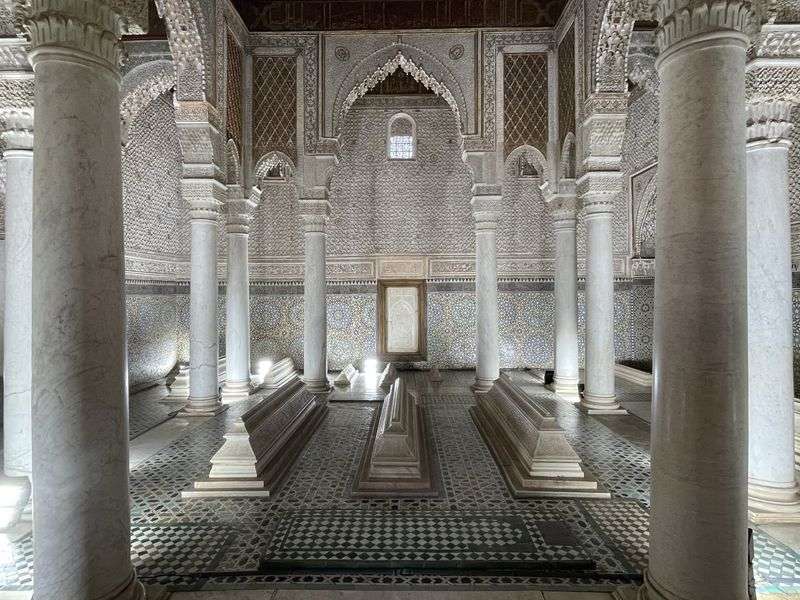
Menara Gardens
Menara Gardens are another brilliant example of Islamic architecture and culture. These gardens are a popular destination for both tourists and locals and have existed for many centuries. More specifically, they were constructed in the 12th century by the Almohad dynasty. The gardens were originally used as an agricultural area, with the surrounding walls and towers providing protection from intruders. Over time, they were expanded and improved, with the addition of a large swimming pool and gazebo in the 16th century, and later used as a place of relaxation and contemplation for the Sultans of Morocco! Today they are an oasis of green within the city, filled with lush vegetation and fruit trees. Finally, when the sky is clear, you can see the Atlas Mountains reflected in the water of the main pool!

Musee de Dar Si Said- Musee de Marrakech
In Marrakech there are many museums and art spaces that need special attention, but two stand out! The first of these is the Museum of Moroccan Arts and Crafts of Dar Si Said (Musee de Dar Si Said). This particular museum is housed in a magnificent palace, which was built between 1894 and 1900 by Vizier Si Said. It mainly houses a fascinating collection of woven and Moroccan carpets from all corners of the country, as well as Moroccan art wood objects, Berber silver jewelry, oil lamps from Taroudant and ceramic objects. Entrance costs 10 dirhams, which is about 1e.
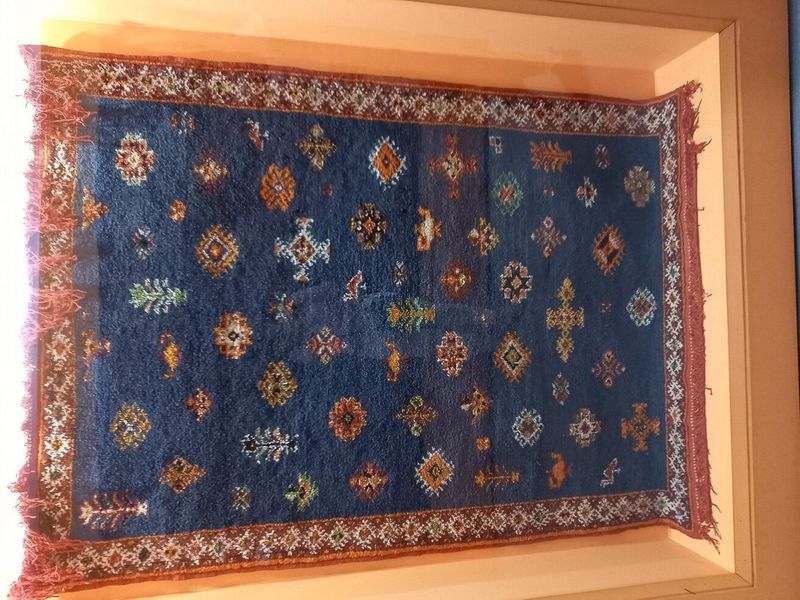
The other museum in the city that you should not miss is the Museum of Marrakech (Musee de Marrakech). And this is housed in a former 19th-century palace, Dar Menebhi, which was the residence of Mehdi Mnebhi, Minister of Defense of Abdelaziz of Morocco. One of the highlights of the museum is the atrium, with its highly impressive light fixture and the rooms around the traditional courtyard. These rooms house the collection of the Marrakesh museum, consisting mainly of weapons, pottery and other traditional Moroccan objects. Entrance to the museum costs 70 dirhams, which is about 6.5e.
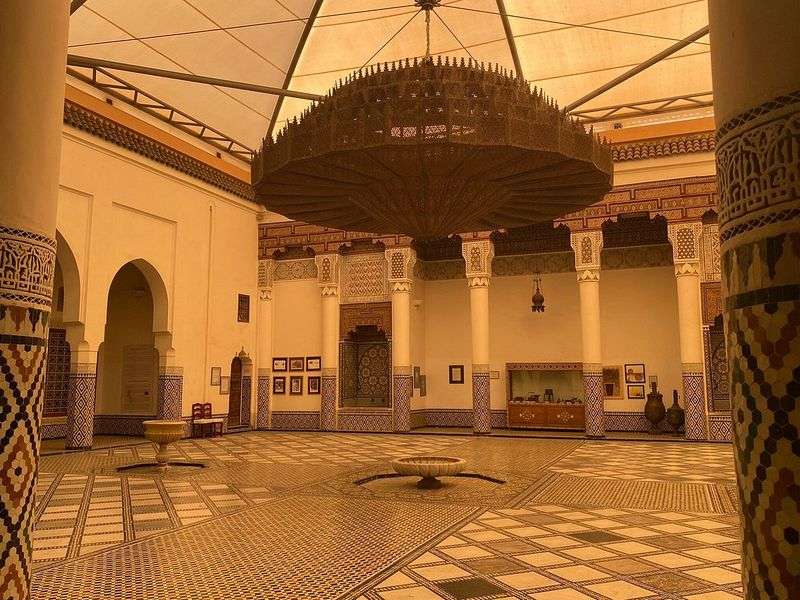
How to go
At the moment, Thessaloniki is not directly connected by air to Marrakesh. The best option is a combination of Aegean, Ryanair and Wizzair flights with intermediate flights in Milan and London, where with proper planning you can find tickets starting from €208 round trip!
Where to stay
Marrakech is a highly tourist city which implies a wealth of accommodation. In my opinion, being in the city and generally in Morocco, you have to experience staying in a riad. Riad is old traditional houses or palaces with internal courtyard, which have now been renovated and function as accommodation. So my suggestion is Riad Douja, which is a charming little Riad next to Marrakech's main square, run by incredibly friendly and welcoming people.
How to move
Marrakech has various means of transport, although the only way to discover Medina is on foot. Of course, orientating yourself inside the old yown is somewhat difficult, since the maps on the internet are not very detailed! So there is a chance that the names of the streets are different from the signs, while if you ask a local for directions, it is customary to accompany you with force and then ask for money! However, in the city there are buses, which are relatively old and usually crowded with people, horse-drawn carriages for a more vintage experience and taxis, which are relatively inexpensive and can be found everywhere. However, it is advisable to ask in advance the price, because they do not usually use taximeters and you may find yourself surprised.
What to eat
Moroccan cuisine is considered the best in Africa and one of the tastiest in the whole world. It has influences from Andalusia, Arabia and France and is characterized by unique flavors and combinations, such as sardines with cilantro, parsley, cumin and chili or pie with pigeon meat, cinnamon and sugar and more. Some of the most famous dishes in the country are Tagine, which is an earthenware dish with the conical lid and is used for cooking various meats and vegetables. Especially popular is the famous couscous, Harira (soup with tomatoes, lentils, chickpeas and lamb), B'ssara (soup with dried broad beans), Chermoula fish (grilled fish marinated with herbs and spices), meatballs, Zaalouk (eggplant salad), Makouda (small balls of fried potatoes) and finally B'stilla (layers of leaf with a mixture of pigeon meat, almonds and eggs, sprinkled with saffron, cinnamon and fresh coriander). Of course, before or after every meal the locals drink Moroccan whiskey, which is none other than peppermint tea! To taste traditional flavors without fear I recommend Atay Café-Food, Chez Brahim and Zeitoun Café, while do not forget to try something from the canteens of the central square. We chose the number 52 and were completely satisfied. Ultimately, for coffee or tea overlooking the square, I recommend Le Grand Balco Café Glacier and Café de France.
Useful information

In Marrakesh we travel with a Passport valid for at least 6 months. You do not need a Visa to enter the country.
In Marrakesh, the language used is, of course, Arabic, but the majority also know French. Of course, due to the tourist development of the country in recent years, everyone speaks English too!
The country's currency is the Moroccan dirham (MAD) and its current exchange rate is €1 = 11.21 dirhams. Many small shops in the bazaars accept dollars and euros.
I suggest you transfer your money to some bank in the city where they keep the lowest fee and not to exchange offices!
Marrakech is two hours behind Greece (GMT +1).
For your journey to and from Marrakesh airport, I suggest you choose a taxi, as the distance is short and the cost minimal!
There is no Greek embassy or consulate in Marrakesh so if you need anything you should contact the nearest one, located in Rabat at 18 Rue Aït Hdidou, Souissi and its telephone numbers are +212537 638964, 638975.
The best time to go to Marrakech is either autumn or spring, when the temperatures are at normal levels.
Recommended excursions → Essaouira, Ouzoud Falls, Merzouga
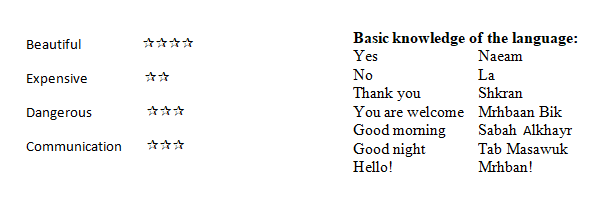
If this article seemed interesting or contributed to your quality information, then you can like my facebook page: o_thessalonikios or follow me on instagram!
Mouzakidis Pantelis








